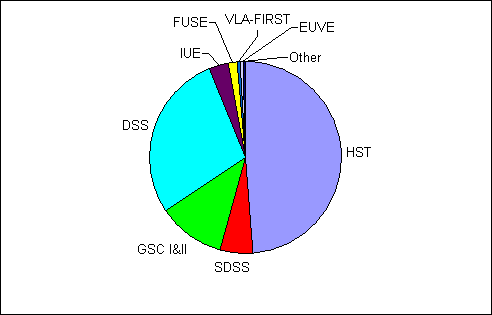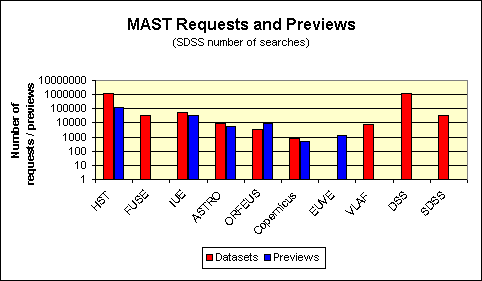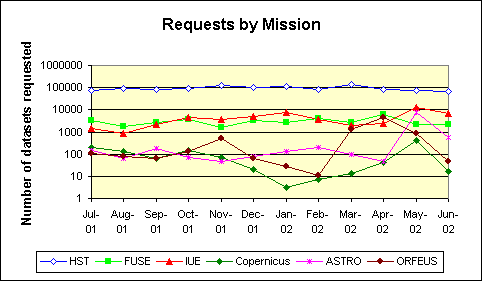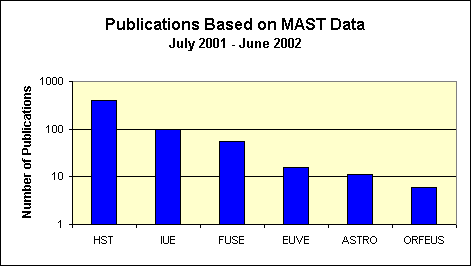|
|||||||||||||||||||
|
|
|||||||||||||||||||
|
|
NASA Data Center Annual Program Plan
| Program Year: | FY 2003 |
| Data Center/Service: | Multi-mission Archive at Space Telescope (MAST)
(Optical/UV Science Archive Research Center) |
| Supporting Organization: | Space Telescope Science Institute
3700 San Martin Drive Baltimore, MD 21218 |
Overall Mission: MAST supports active and legacy mission data sets and related catalogs and surveys, focusing primarily on data in the ultraviolet, optical, and near-IR parts of the spectrum. Support includes curation of the data, providing expert support to users of the data, providing access to data-specific calibration and analysis software, providing user support for this software, and maintaining public access interfaces to the data. MAST works with new mission teams in the supported wavelength regions to assist in the development of data management plans, especially in the areas of data formats, descriptive metadata and standardization of keywords, in the development of data access and data delivery plans, and in assuring data quality control.

MAST Data Holdings
| Name | Size | Number of Observations | Active Mission Duration |
|---|---|---|---|
| ACTIVE MISSIONS | |||
| FUSE | 221 GB | 2214 | 1999- |
| HST | 8.6 TB | 266,926 | 1990- |
| LEGACY MISSIONS | |||
| ORFEUS: BEFS | 4.1 GB | 332 | Sept. 1993; Nov. 1996 |
| ORFEUS: IMAPS | 0.3 GB | 643 | Sept. 1993; Nov. 1996 |
| ORFEUS: TUES | 0.2 GB | 229 | Nov. 1996 |
| EUVE | 96 GB | 1377 | 1992-Jan. 2001 |
| ASTRO: UIT | 56 GB | 1,442 | Dec. 1990; March 1995 |
| ASTRO: HUT | 0.6 GB | 516 | Dec. 1990; March 1995 |
| ASTRO: WUPPE | 0.1 GB | 238 | Dec. 1990; March 1995 |
| IUE Final Archive | 475 GB | 103,552 | 1978-1996 |
| IUE SIPS | 125 GB | 104,296 | 1978-1996 |
| Copernicus | 0.8 GB | 551 | 1972-1981 |
| CATALOGS & SURVEYS | |||
| SDSS: Early Data Release | 1 TB | n/a | 1998- |
| VLA-FIRST | 109 GB | 14,940 | 1993- |
| Digitized Sky Surveys | 5 TB | n/a | 1950-58, 1975-99 |
| GSC I, II | 2 TB | n/a | 1950-58, 1975-99 |
Services Provided: MAST provides support for users seeking to understand the properties and instrumental signatures of all archived data sets and assistance with the interfaces to browse and retrieve these data. Access to non-HST mission and instrument specific calibration and analysis software and assistance in its use is on a best-effort basis (full support for HST related software is provided by the MAST Helpdesk and staff).
Non-HST Data Analysis Software Provided: IUE RDAF package (IDL-based), IUE Final Archive processing software (IRAF port), EUVE analysis software package (IRAF-based), Copernicus data analysis software (IDL-based), UIT data reduction and analysis software (FORTRAN, C, and IDL routines), WUPPE data analysis software (FORTRAN routines requiring the FITSIO library), and HUT data reduction software (IRAF-based) are available through MAST.
Mission Interfaces: MAST staff members continued to coordinate with the FUSE mission on data ingest, creation of preview data, database queries, and web access. The FUSE Project has undertaken a reprocessing effort to improve the quality of the processed data and to provide files suitable for the "quick look" preview data that are made available through the MAST archive.
Staff members coordinated with the GALEX team in drafting the Interface Control Document (ICD), which specifies data characteristics, file structure, keyword definitions, and delivery mode. A preliminary database has been created using data models and file and keyword information. Test queries based on GALEX team input have are being used to help define the user interface. A detailed testing and implementation plan has been created, in preparation for the launch of GALEX later this year.
MAST has developed working relationships with the teams from three planned NASA missions: Kepler, a newly approved Discovery mission to detect planets; the Cosmic Hot Interstellar Plasma Spectrometer (CHIPS), a University-class Explorer mission; and the Spectroscopy and Photometry of the IGMs Diffuse Radiation (SPIDR), a Small Explorer class mission. All three projects plan to archive their data with MAST. Staff members continued to coordinate with teams from the ORFEUS Project, the Sloan Digital Sky Survey (SDSS), and Voyager UVS.
Interoperability Activities: MAST is working with the Astrophysics Data Centers Executive Council (ADEC) on a project to build a simple interoperability framework among the NASA data centers. This project will initially act as a referring service in a Web-based search, pointing MAST users to relevant data at other data centers and alerting users at other data centers of MAST data that may be of interest. This project has the immediate goal of improving the interaction between data centers, and will also help lay the interoperability groundwork for the VO.
MAST has provided leadership on a collaborative literature link project between the ADEC and the scientific journals. The goal of the project is to define ways to structure dataset identifiers and object names that can be used by authors to identify datasets and astronomical sources in a published article. This would permit the automatic association between journal articles and their associated datasets and objects, and vice versa; the current MAST literature link activity is labor-intensive. MAST staff members are developing a dataset verifier tool to facilitate the literature link project as well as data access among the various centers. The software tool parses a dataset name, verifies the format, and checks for the existence of the dataset.
Major Activities and Accomplishments of the Past Year:
Data Ingest and Retrievals: The rate of data ingested into the archive continued to grow, with 2.0 TB of data coming from the active missions HST and FUSE. Data retrievals from the same missions was 9.2 TB, which exceeds the size of the entire HST and FUSE archives (8.8 TB). The addition of a RAID array to the distribution system has permitted MAST to provide faster access to non-HST/FUSE data and a larger staging area for HST and FUSE data. The non-HST/FUSE data originally stored on a CD jukebox is now also stored on the RAID array, allowing immediate access to the files.
The large size of ACS files poses logistical problems for transfer of these files to users. Staff members created a "FastAccess" area on the MAST website from which users can retrieve popular and non-proprietary ACS files via ftp, including ACS Early Release Observations (ERO) and the Great Observatories Origins Deep Survey (GOODS) observations. Over 2500 individual ACS files from the ERO and GOODS programs have been retrieved from the site by about 200 users thus far.
MAST Data Ingest & Retrieval Activity
| Date | Ingest Volume (GB) - Active Missions | Retrieval Volume (GB) - Active Missions | Retrieval Volume (GB) - Legacy Missions | Datasets Retrieved - Active Missions | Datasets Retrieved - Legacy Missions |
|---|---|---|---|---|---|
| Jul 2001 | 102.0 | 655.5 | 3.4 | 78572 | 2046 |
| Aug 2001 | 129.9 | 717.2 | 2.0 | 92075 | 1260 |
| Sep 2001 | 112.6 | 640.2 | 1.3 | 88996 | 2541 |
| Oct 2001 | 126.4 | 690.3 | 7.9 | 93303 | 5869 |
| Nov 2001 | 110.2 | 745.6 | 1.3 | 125264 | 4168 |
| Dec 2001 | 105.2 | 682.1 | 6.8 | 101499 | 6038 |
| Jan 2002 | 129.9 | 735.1 | 2.9 | 113238 | 7687 |
| Feb 2002 | 109.2 | 690.0 | 7.0 | 85553 | 4310 |
| Mar 2002 | 134.6 | 904.7 | 12.2 | 136705 | 5061 |
| Apr 2002 | 257.0 | 957.2 | 5.2 | 89875 | 7146 |
| May 2002 | 339.0 | 967.4 | 34.1 | 76942 | 26848 |
| Jun 2002 | 382.8 | 832.8 | 2.0 | 69713 | 7493 |
| TOTALS | 2.0 TB | 9.2 TB | 86.1 GB | 1,151,735 | 80,467 |


Research Tools for Data Exploration and Evaluation: MAST members continued to develop new capabilties for researchers to locate and evaluate data available from the archive.
- Pointings Tables and Search Tool. The new "pointings" tool allows the user to search for HST images in a more powerful way. A researcher may query the pointings tables to find specific regions in the sky, i.e. pointings, that fulfill requirements such as having been observed several times, in multiple bandpasses, within a range of galactic latitude, and with a limited timespan. Tables of pointings have been created for WFPC2, STIS, and FOC images thus far.
- MAST Scrapbook. The "MAST Spectral and Image Scrapbook" allowed a researcher to select and view representative MAST data for an astronomical object. The initial release, which included EUVE, FOS, GHRS, HUT, IUE, and WFPC2, was enhanced with the addition of the STIS, FOC, HUT, UIT, WUPPE, BEFS, and TUES data. In addition, staff members added the capability to select and display selected scrapbook spectra from various instruments. Editor's Note - Sept. 2024: The Scrapbook has since been retired.

High-Level Science Products: Guidelines have been established for the contribution of High-Level Science Products (HLSP) to MAST. HLSP are defined as fully reduced and processed images and spectra from the MAST missions, as well as closely related ground-based observations, theoretical data products, object catalogs, and original reduction/analysis software. Science-ready products currently available include atlases, sky surveys, and catalogs created using various MAST mission datasets including HST, IUE, FUSE, EUVE, Copernicus, and the Sloan DSS. In addition, major contributions are expected from the HST Treasury, Archival Legacy, and Large programs begun in Cycle 11.
WFPC2 Association Project: A collaboration between MAST, the Canadian Astronomy Data Center (CADC), and the ST-European Coordinating Facility (ST-ECF) was recently undertaken to make combined WFPC2 images available jointly from each of the three archives. These images represent combinations of individual WFPC2 images of a given field taken with a given filter, and are being created for the entire WFPC2 archive using software developed by CADC and ST-ECF. The combined images will enhance the existing archives by providing deep images suitable for scientific analysis and better previews of these fields.
User Interface Enhancements:
- Customized and Multiple Spectral Plots. The interactive plotting option, originally available on the HUT, IUE, and EUVE preview pages, has been enhanced to handle WUPPE data. Users may also select spectra from an IUE or EUVE search to coplot interactively. The coplotting capability has been enhanced to allow scaling of individual spectra.
- Proposal Information. Observing program abstracts have been placed online for IUE, and EUVE abstracts will soon be made available. The abstracts are linked with the associated data that were obtained under the individual programs. The new information makes it possible for researchers to better understand the observing strategy and techniques used by the original observers. Links to the scientific publications complete the end-to-end documentation of the scientific utilization of the data.

- Publications and Literature Links. The publications database and the links between scientific publications and the MAST datasets they involve were updated as new publications became available through the ADS. About 1/8 of all publications involving MAST datasets involved more than one mission. The HST publications database was brought up to date following the same criteria used for other MAST datasets. A list of MAST-based papers can now be searched at the Astrophysics Data System (ADS), which now provides dedicated forms for HST and IUE papers, accessible at http://adsabs.harvard.edu/Groups/search/HST and http://adsabs.harvard.edu/Groups/search/IUE. Users can search on all the usual ADS fields, which include authors, object names, and abstract. Alternatively, one can scroll down the ADS main page (http://adsabs.harvard.edu/abstract_service.html), select "At least one of the following groups (OR)", and then select HST and/or IUE from the group list.
- Observatory Technical Publications. A pilot project was undertaken to make handbooks and technical publications provided by the various MAST missions easier for users to locate. Many of the handbooks were not distributed widely or are now available only from the MAST website, but contain essential information for researchers working with the data. A staff member worked with the ADS to create entries for the handbooks, allowing researchers to query the widely used ADS database to locate the technical information they need.
- Press Releases. Three STScI press releases were based on MAST data.
- PR01-19: "Magnetic Fields Weave Rings Around Stars". Rings of material were found around massive stars, formed due to stellar winds and magnetic fields.
- PR01-27: "New View of Primordial Helium Traces the Structure of Early Universe". FUSE observations were used to find intergalactic helium, tracing the structure of the early universe.
- PR01-29: "Ancient Black Hole Speeds Through Sun's Galactic Neighborhood". DSS images were used to discover a nearby ancient black hole, XTE J1118+480.

Plans and Schedule for the Coming Year:
MAST plans to continue to enhance the interoperability and scientific utility of our data holdings in the coming year through activities in the following areas.
Additional Ultraviolet and Optical Data Sets
- Continue to incorporate additional ultraviolet and optical data sets as they become available, including data from the active missions FUSE and HST.
- Complete preparations for supporting the GALEX data archive, including the completion of the ICD, the database, and the user interface. GALEX is expected to launch late this year, with the first delivery of data in 2004.
- Coordinate with the Kepler project to put together plans for the development of the ground system, including the Data Management Center which will involve MAST. STScI will provide data receipt, calibration and archiving of the photometry for 100,000 stars measured every 15 minutes at extremely high precision over several years. Launch is planned for 2007.
- Continue to work with new astrophysics mission projects, including the CHIPS and SPIDR teams to assure access to these data sets via MAST and to help them develop plans for data delivery and long-term data access. CHIPS is expected to launch in late 2002, with the delivery of data in 2004. SPIDR is expected to launch in 2005.
Improved Services for Archival Researchers
- The Pointings tool will be enhanced by including additional datasets
and permitting queries of multiple tables.
- MAST will continue to upgrade the MAST website to improve capabilities and navigability. Complete the redesign of the catalog search software to make it more flexible and maintainable. New capabilities will be incorporated to improve search engines, handle very large databases, provide new interactive research tools, and promote interoperability.
- Staff members will work with Starview and Specview developers to incorporate new spectral analysis tools into Starview and into the web interface.
- MAST will continue to provide assistance for archival researchers with questions about searches, retrievals, data characteristics, analysis software, and other issues related to MAST data.
- Continue to acquire and make available High-Level Science data products, including those from the HST Treasury, Archive Legacy, and Large programs and the combined WFPC2 images.
- In collaboration with the Chandra Data Archive (CDA), MAST will implement an interface to coordinated HST/Chandra observing programs, which will also link the two observatories in a more general way.
- Continue leadership of literature link project through participation in ADEC. Establish guidelines for electronic data identification standards.
- Participate in the development of prototype query services for the National Virtual Observatory.
- Continue active participation in the Astrophysics Data Center Executive Council.
|
|
|




 Follow Us
Follow Us